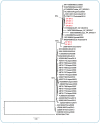Characterization of insect-specific Culex flavivirus (Flaviviridae) nucleotide sequences in mosquitoes from urban parks in São Paulo, Brazil
- PMID: 36169488
- PMCID: PMC9549946
- DOI: 10.1590/0037-8682-0067-2022
Characterization of insect-specific Culex flavivirus (Flaviviridae) nucleotide sequences in mosquitoes from urban parks in São Paulo, Brazil
Abstract
Background: Despite their worldwide occurrence, the distribution and role of insect-specific flaviviruses (ISFs) remain unclear.
Methods: We evaluated the presence of ISFs in mosquitoes collected in São Paulo, Brazil, using reverse transcription and semi-nested polymerase chain reaction (PCR). Some of the positive samples were subjected to nanopore sequencing.
Results: Twelve mosquito pools (2.8%) tested positive for flavivirus infection. Nanopore sequencing was successfully performed on six samples. Phylogenetic analysis grouped these sequences into genotype 2 of Culex flavivirus (CxFV).
Conclusions: The identification of CxFV genotype 2 at new locations in São Paulo highlights the importance of understanding the role of ISFs in mosquito vector competence.
Conflict of interest statement
Figures

References
-
- Fernandes LN, de Paula MB, Araújo AB, Gonçalves EF, Romano CM, Natal D, et al. Detection of Culex flavivirus and Aedes flavivirus nucleotide sequences in mosquitoes from parks in the city of São Paulo, Brazil. Acta Trop. 2016;157:73–83. - PubMed
-
- Machado DC, Mondini A, Santana VS, Yonamine PTK, Chiaravalloti F, Neto, Zanotto PMA, et al. First Identification of Culex flavivirus (Flaviviridae) in Brazil. Intervirol. 2012;55(6):475–483. - PubMed
-
- Hoshino K, Isawa H, Tsuda Y, Yano K, Sasaki T, Yuda M, et al. Genetic characterization of a new insect flavivirus isolated from Culex pipiens mosquito in Japan. Virol. 2007;359(2):405–414. - PubMed
MeSH terms
LinkOut - more resources
Full Text Sources
Medical

